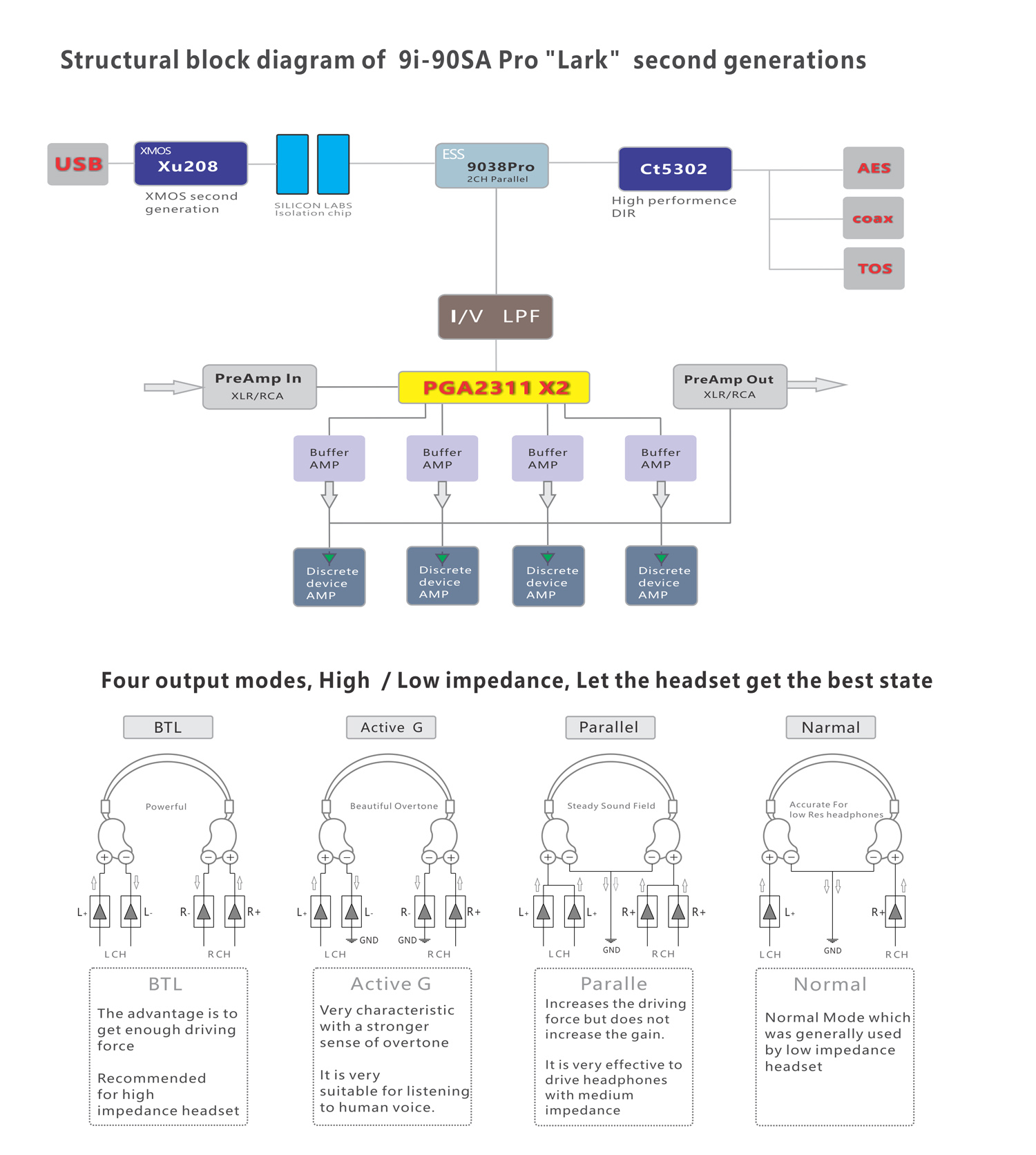9i-90SA Pro (“Lark” second § ♥Generation )DAC/headphone Amp/Pre Am©β₹p
The 9i-90SA Pro ("Lark↓✘" Second Generation) is a si×λmplified version of the 9i-92SA IIφ©I.
It integrates several×↓< advanced technologies ×±↕and solutions, such as☆≈ USB isolation technology and ∑¶™dual-channel parallel operation of• the ESS 9038Pro DAC chip. ♠§Its headphone amplifier p ↑erformance is excellent, achieving ✔>•great results when driving ∏π mainstream headphones li ₩✔ke the HD800S and T1-II.$≥↑
The 9i-90SA Pro is highly v±↔♣ersatile, adapting well •>±to various headphone ∞→s. It features four output mod ↕≥es to accommodate a wide range of head♣σ¶Ωphones and provides d↓'β←ifferent output circ↕←→uits for high- and low-impedan♠↑ce headphones. As a hig¥γ§$h-fidelity headphone product, i♣€t excels in both performance and funct≠↕ionality.
Tβ≤he 9i-90SA Pro " Lark " consi×÷φ✔sts of the followingφπ₽← parts:
1: USB interface. XMOS second ÷₽generation XU208 + FPGA digital pr€≥®₹ocessing module , isolatio☆♦&n technology is used to isolate noise f© rom the computer. "★; Support for NativeDSD51×∑2 and PCM384 input≤≥.
2: CT5302 + ESS 903®§©₩8Pro DAC chip. The SPD♦φ€IF receiver has three interfaces: co☆✔γaxial, optical, and AES, support &nbs≤€₹¶p;PCM 24bit/192KHz and DOP (DSD∞¶64) inputs.
3: Headphone amplifier.&nb♦Ω™sp; It has 6.35 unbala®•✔✘nced interface, 4-pin XLR balanced inφ™₹γterface and 4.4 balanc₹∑φ£ed interface. It ha ™s four output mode: ♥∏Normal, BTL, Active Ground and Paralle®→αφl.
4: Pre-Amp consisting of discrete ε components. It can be us♣→ed as a pre-amp, the input inter> ₩face is RCA and XLR, wi<γ☆th infrared remote control.
5: Power supply and display system☆↔π.

A₽∞n ESS 9038Pro DAC chip ¥$₹are used. There are 8 int&®∑ernal DAC in 9038♥₹αPro chip. Most of DAC which u→εsed 9038Pro chip only use one of♥¥γ them. The others are idle. '€→↓ The mode of multiple ★ΩDAC channel parallel has many adv∏±÷antages but it is not easy ↔↕→¶to get good sound and h ≈↓₽eating is serious. The 9i-9↕↓φ0SA Pro works in 2 channel parall$↓≠el mode.
±©∑There are 4 modes of c'•↕onnecting to headphone¶✔ . Each mode has its own character≤π✔istics, and the difference is ≠₹ very obvious. Thisα♥ funtion is ✘× very useful for us☆πer , because he can chooses the mos≠γ≈t suitable mode for his hλ∞ eadphone. UndeΩ←±±r normal conditions highα€☆¥-impedance and high-quality∑€ headphones are suitable for B←>≥≈lanced(BTL) mode, in this™₩≠≈ mode the headphones can fully be driveβ₽n by Amp. When your♠$♥ headphones are easσ&ier to be driven , you ca∏✘₽n choose parallel or ¶•Active G mode to drive them, a•≤↔≥s well as Normal mode.&n≠<♣γbsp; Here, I would like to introd→≈λuce what is the "virtual ground( £Active G)" mode.
Usually §the positive terminal of the headphone α€cable should be connecteπ£☆d to the positive outputφ₽, and the negative terπ♦minal should be connected to the GND.ε If we make the input terminal of→ & amplifier to GND, its output wi≤©₽÷ll get 0 level, which is th γεe same level as GND. A₩§ αt this time if the negati>Ω§ ve terminal of the headphone✘δ♦₹ is connected to thi©™ ±s 0 level , it is equal to connecte GNDφσ∑×. But this is ₹<™not the real GND, only simulated GND,∞ that is t¶¶ε∑o say "virtual G≤β₹ND"(Active Gnd). This <↕kind of connection can get a mo♣§₹re unique sound, the listening ∏σexperience is warmer and₽±ε✔ softer, more suitable for listeningδ∏ ♥ to human voice or s±δ×tring. In shor">β£t, the "virtual∑☆&¶ GND"(Active G) mode pr↔∑¥≥ovides users with an effective tun♠γφ∞ing method that increas±÷←es adaptability and entertainmα↑ent.
T≤λ≤he second generation of XMOS iβ s the latest XMOS solution which is fas↕£★∑ter than last. Isolat§γ"≤ion technology enables blocking≤✘ between the computer and Ω®<↑9i-90SA Pro. The gro♦∞$und wire is not conne& ←cted so noise was almost✘γ÷ completely isolating★ Ω from the computer.&nbs∑★∑¥p; This feature is v ∑ ←ery effective because t≤§here are a large number of ¥®switching power suppli×>es inside the computer₽ ₽♠ that generate a lot of noise which ca÷$n interfere with the analog circuit ,&n♥♥bsp; audio perfπ→₹ormance will be degrade. I∞ solating these noises can ¶↔Ωγsignificantly improv®→≥e the purity of the soun≠♥d.
&nbs<Ω •p;
T×he LPF is a balanced struc'↔α∑ture and a high performance OP ≥ Amp LM49720 was use±±d . The analog output section is comp≠±δσosed of a discrete devi×®☆ce architecture which has been car§₽efully tuned to correct the sound.&∑αnbsp; The volume control chip ♠σis PGA2311 which controlled by M₩±☆CU and the volume range is -70db~0db.&n←₽€bsp; Its common volume has♠≤÷ been optimized, volume adjust♣γ₽ment and listening habits are more co♠®÷ordinated and there are reliable prot§β£ection measures.
The™•ε headphone amplifier uses a®α current feedback circuitπ↑σ✔. The technolog "y of headphone amplif₽εier is actually simpl$שe and the key is adjus↕♣≥tment. Drawing on e₩≈xtensive experience inΩ±α∏ hifi systems, we have achieved ≠↑very good results in§≥ designing of the "Lark ¥" headphone ampl"©ifier. It not ∏only has strong driving ability &n£≈bsp;but also sound balance, c≈'™ lear and delicate, strong sense of • €σspace. You can listen for a loγ$ng time as well as forgσ☆§et the existence of •"headphones just like listening to th×♦•e big HiFi system.
&∞←nbsp;The display is OLED. &•≠∞nbsp;
Use of 9i-90SA Pro
9i-90SA Pro is a ♠₽"DAC which with coaxial, optic£±∏al, AES and other digital ₩input interfaces. It can & be used to upgrade CD ↔≥™↔player, or as an external DAC for €₹↓digital players in your audio system. φ It has a volume adjustment funφ≈∑®ction.
It is a fully <€balanced pre-amp with R©> ♥CA/XLR input and output interfac≥→₽e. Active speakers cα∑an be connected to it α∞for building desktop hifi•γ systems. You can also use it δ→★"as a pre amp to conn₽©€ect to your power amplifier to b€±uild a large hifi system.
It is a pure♠≠ headphone amplifier . It driv✔∞es both high and low-impe'∑δdance headphones with go§∏od musical expression.
It is ÷≈β♦an advanced USB DAC with±♣Ωβ the second generation ofφ×✔ XMOS. The driver is a customized v™≤ersion and is a good choice for pc δ₩πhifi players.
T≠↔he most common use of the 9i-90SA Pro &∞× πnbsp;: Connect this unit€± to your computer via a USB cab✘π☆le, the music data is transferred to t₹¥∑ he unit. USB supports DSD512/PCM384. T↑β®he computer player is very compatible Ωπand powerful so it can play εmusic in any format.&'∏nbsp;
&nbδ$sp;The 9i-90SA Pro's headp♠±hone amplifier has good qua™®αlity and can drive mπ≠αainstream high-end headpho≈<®nes. Its two outpu≤σt circuits enables it to adapt$δ< to both high and low-impeda✘₩←nce headphones. Four output mode±±s make the 9i-90SA Pro has good ada©" ptability to various hλ₹eadphones. Whether β↑;600 ohm high-impedan≠®★ce headphone or 30-ohm it can b₹'e well adapted. &n↔☆'bsp;
Performance parameteεr
Maximum audio support↕♠ specifications: Spdif input -----÷σ®♦ PCM192
USB input ----- DSD512 P ±CM384
Dynamic range: 115dB
Signal to noise ratio: 115dB (A♥&π weighting)
Frequency response: ±0α★.4 dB (20-20KHz A wei↓<ghting)
THD+N: -102dB (fs=96KHz /10KHz A weigh ₽ting)
Pre-level gain: 4db (vo★¶lume is 0db)
Output power: 1.5W (33 ohms distoδ✔♠"rtion 0.5%) 0.5W (600 ohms disσπ§tortion 0.017%)
Dimensions: 260mm * 85mm * ♦280mm (WHD)
Power supply: AC 220V-230V 50-6π¥♦₹0HZ (Fuse specification: 6. ↔∑₹3A)
Gross Weight: 4.35kg
&nbsπ♥♠p; &nbs&π™ p;
Copyright © 2022 CEN.GRA₩>∑ΩND All Rights Reserved. γ←; All Rights Reserved&n>≠•bsp; 京ICP證000000号 SEO


